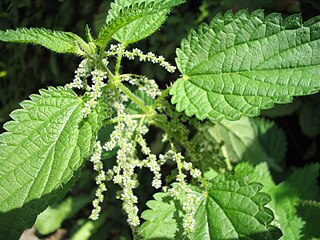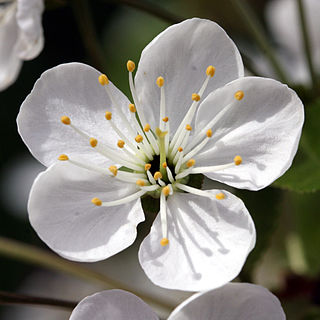Related Research Articles

Asparagales is an order of plants in modern classification systems such as the Angiosperm Phylogeny Group (APG) and the Angiosperm Phylogeny Web. The order takes its name from the type family Asparagaceae and is placed in the monocots amongst the lilioid monocots. The order has only recently been recognized in classification systems. It was first put forward by Huber in 1977 and later taken up in the Dahlgren system of 1985 and then the APG in 1998, 2003 and 2009. Before this, many of its families were assigned to the old order Liliales, a very large order containing almost all monocots with colorful tepals and lacking starch in their endosperm. DNA sequence analysis indicated that many of the taxa previously included in Liliales should actually be redistributed over three orders, Liliales, Asparagales, and Dioscoreales. The boundaries of the Asparagales and of its families have undergone a series of changes in recent years; future research may lead to further changes and ultimately greater stability. In the APG circumscription, Asparagales is the largest order of monocots with 14 families, 1,122 genera, and about 36,000 species.

The Malpighiales comprise one of the largest orders of flowering plants, containing about 36 families and more than 16,000 species, about 7.8% of the eudicots. The order is very diverse, containing plants as different as the willow, violet, poinsettia, manchineel, rafflesia and coca plant, and are hard to recognize except with molecular phylogenetic evidence. It is not part of any of the classification systems based only on plant morphology. Molecular clock calculations estimate the origin of stem group Malpighiales at around 100 million years ago (Mya) and the origin of crown group Malpighiales at about 90 Mya.

Rosales is an order of flowering plants. It is sister to a clade consisting of Fagales and Cucurbitales. It contains about 7,700 species, distributed into about 260 genera. Rosales comprise nine families, the type family being the rose family, Rosaceae. The largest of these families are Rosaceae (90/2500) and Urticaceae (54/2600). The order Rosales is divided into three clades that have never been assigned a taxonomic rank. The basal clade consists of the family Rosaceae; another clade consists of four families, including Rhamnaceae; and the third clade consists of the four urticalean families.

Under the International Code of Nomenclature for algae, fungi, and plants (ICN), Rosidae is a botanical name at the rank of subclass. Circumscription of the subclass will vary with the taxonomic system being used; the only requirement being that it includes the family Rosaceae.

The Moraceae — often called the mulberry family or fig family — are a family of flowering plants comprising about 38 genera and over 1100 species. Most are widespread in tropical and subtropical regions, less so in temperate climates; however, their distribution is cosmopolitan overall. The only synapomorphy within the Moraceae is presence of laticifers and milky sap in all parenchymatous tissues, but generally useful field characters include two carpels sometimes with one reduced, compound inconspicuous flowers, and compound fruits. The family includes well-known plants such as the fig, banyan, breadfruit, jackfruit, mulberry, and Osage orange. The 'flowers' of Moraceae are often pseudanthia.

Geraniales is a small order of flowering plants, included within the rosid subclade of eudicots. The largest family in the order is Geraniaceae with over 800 species. In addition, the order includes the smaller Francoaceae with about 40 species. Most Geraniales are herbaceous, but there are also shrubs and small trees.

The Urticaceae are a family, the nettle family, of flowering plants. The family name comes from the genus Urtica. The Urticaceae include a number of well-known and useful plants, including nettles in the genus Urtica, ramie, māmaki, and ajlai.

The Ulmaceae are a family of flowering plants that includes the elms, and the zelkovas. Members of the family are widely distributed throughout the north temperate zone, and have a scattered distribution elsewhere except for Australasia.

The Primulaceae, commonly known as the primrose family, are a family of herbaceous and woody flowering plants including some favourite garden plants and wildflowers. Most are perennial though some species, such as scarlet pimpernel, are annuals.

Trema is a genus of about 15 species of evergreen trees closely related to the hackberries (Celtis), occurring in subtropical and tropical regions of southern Asia, northern Australasia, Africa, South and Central America, and parts of North America. They are generally small trees, reaching 10–20 m (33–66 ft) tall.
Hamamelididae is an obsolete botanical name at the rank of subclass. Because some hamamelidid members bear aments, this subclass has been formerly known as Amentiferae. Based on molecular phylogeny works, Hamamelididae appears to be a polyphyletic group.

The rosids are members of a large clade of flowering plants, containing about 70,000 species, more than a quarter of all angiosperms.

In plant taxonomy, commelinids is a clade of flowering plants within the monocots, distinguished by having cell walls containing ferulic acid.

Urera is a genus of flowering plants in the nettle family, Urticaceae. It has a pantropical distribution.
The APG III system of flowering plant classification is the third version of a modern, mostly molecular-based, system of plant taxonomy being developed by the Angiosperm Phylogeny Group (APG). Published in 2009, it was superseded in 2016 by a further revision, the APG IV system.

Cannabaceae is a small family of flowering plants, known as the hemp family. As now circumscribed, the family includes about 170 species grouped in about 11 genera, including Cannabis (hemp), Humulus (hops) and Celtis (hackberries). Celtis is by far the largest genus, containing about 100 species.

Narcisseae is a small tribe of plants belonging to the subfamily Amaryllidoideae of the Amaryllis family (Amaryllidaceae), where it forms part of the Eurasian clade, and is one of three tribes in the European (Mediterranean) clade. It contains two genera and approximately 58 species, but probably also Lapiedra. The two genera are distinguished from each other by the presence of a paraperigonium in the former.
Durioneae is a tribe within the subfamily Helicteroideae of the plant family Malvaceae s.l. The tribe contains at least five genera, including Durio, the genus of tree species that produce Durian fruits.

In phylogenetic nomenclature, the Pentapetalae are a large group of eudicots that were informally referred to as the "core eudicots" in some papers on angiosperm phylogenetics. They comprise an extremely large and diverse group that accounting about 65% of the species richness of the angiosperms, with wide variability in habit, morphology, chemistry, geographic distribution, and other attributes. Classical systematics, based solely on morphological information, was not able to recognize this group. In fact, the circumscription of the Pentapetalae as a clade is based on strong evidence obtained from DNA molecular analysis data.
References
- ↑ Shu-dong Zhang, Douglas E. Soltis, Yang Yang, De-zhu Li, and Ting-shuang Yi. "Multi-gene analysis provides a well-supported phylogeny of Rosales". Molecular Phylogenetics and Evolution60(1):21-28.
- ↑ Kenneth J. Sytsma, Jeffery Morawetz, J. Chris Pires, Molly Nepokroeff, Elena Conti, Michelle Zjhra, Jocelyn C. Hall, and Mark W. Chase. (2002). Urticalean rosids: Circumscription, rosid ancestry, and phylogenetics based on rbcL, trnL-F, and ndhF sequences. American Journal of Botany 89(9): 1531-1546. PDF fulltext
- ↑ Qiu Y.-L. M. W. Chase S. B. Hoot E. Conti P. R. Crane K. J. Sytsma C. R. Parks 1998. Phylogenetics of the Hamamelidae and their allies: parsimony analyses of nucleotide sequences of the plastid gene rbcL. International Journal of Plant Sciences 159: 891-905.
- ↑ APG (Angiosperm Phylogeny Group). 1998. An ordinal classification for the families of flowering plants. Annals of the Missouri Botanical Garden 85: 531-553.
- 1 2 Sytsma, Kenneth J., Jeffery Morawetz, J. Chris Pires, Molly Nepokroeff, Elena Conti, Michelle Zjra, Jocelyn C. Hall, and Mark W. Chase. 2001. Urticalean Rosids: Circumscription, Rosid Ancestry, and Phylogenetics Based on RbcL, TrnL-F, and NdhF Sequences. American Journal of Botany
- ↑ Tobe H. and T. Takaso 1996. Trichome micromorphology in Celtidaceae and Ulmaceae (Urticales). Acta Phytotaxonomica et Geobotanica 47: 153–168.
- 1 2 3 4 5 6 Judd W. S. C. S. Campbell E. A. Kellogg P. F. Stevens 1999. Plant systematics: a phylogenetic approach. Sinauer Associates, Sunderland, Massachusetts, USA.
- 1 2 3 4 5 6 Stevens P. F. 2001. Angiosperm phylogeny website, v. 2, August 2001. http://www.mobot.org/MOBOT/research/APweb/.